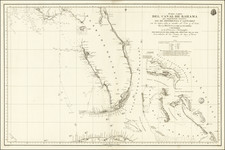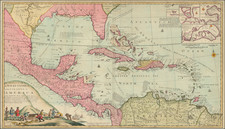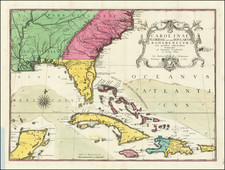Striking image showing the commencement of construction on Fort Caroline on the River Maij (May), the first French Colony in what would become the United States, in the vicinity of Jacksonville, Florida. One of the earliest obtainable images of a European settlement in the modern-day US.
Built in 1564 and destroyed by the Spanish the following year, the fort was laid out in a triangular format and constructed of mounded earth and logs.
A French expedition, organized by Protestant leader, Admiral Gaspard de Coligny, and led by the Norman navigator, Jean Ribault landed at the site on the River of May (now the St. Johns River), in February 1562, before moving north to Port Royal Sound. There, on present-day Parris Island, South Carolina, Ribault left twenty-eight men to build a settlement known as Charlesfort. Ribault then returned to Europe to arrange supplies for the new colony but was arrested in England due to complications arising from the French Wars of Religion, which prevented his return.
Without supplies or leadership, and beset by hostility from the native populations, all but one of the colonists sailed back to Europe after only a year. During their voyage in an open boat, they were reduced to cannibalism before the survivors were rescued in English waters. Meanwhile, René Goulaine de Laudonnière, who had been Ribault's second-in-command on the 1562 expedition, led a contingent of around 200 new settlers back to Florida, where they founded Fort Caroline (or Fort de la Caroline) atop St. Johns Bluff on June 22, 1564. The fort was named for the reigning French king, Charles IX. For just over a year, this colony was beset by hunger, Indian attacks, and mutiny, and attracted the attention of Spanish authorities who considered it a challenge to their control over the area.
In June of 1565, Ribault had been released from English custody, and Coligny sent him back to Florida. In late August, Ribault arrived at Fort Caroline with a large fleet and hundreds of soldiers and settlers and took command of the settlement. However, the recently appointed Spanish Governor of Florida, Don Pedro Menéndez de Avilés, had simultaneously been dispatched from Spain with orders to remove the French outpost, and arrived within days of Ribault's landing. After a brief skirmish between Ribault's ships and Menéndez's ships, the latter retreated 35 miles south, where they established the settlement of St. Augustine. Ribault pursued the Spanish with several of his ships and most of his troops, but he was surprised at sea by a violent storm lasting several days. In a bold stroke, Menéndez marched his forces overland, launching a surprise dawn attack on the Fort Caroline garrison which then numbered about 200 to 250 people. The only survivors were about 50 women and children who were taken prisoner and a few defenders, including Laudonnière, who managed to escape; the rest were executed.
As for Ribault's fleet, all of the ships either sank or ran aground south of St. Augustine during the storm, and many of the Frenchmen on-board were lost at sea. Ribault and his marooned sailors were located by Menéndez and his troops and summoned to surrender. Apparently believing that his men would be well treated, Ribault capitulated. Menéndez then executed Ribault and several hundred Frenchmen as Lutheran heretics at a place now known as Matanzas ("massacres") Inlet. This atrocity shocked Europeans even in that bloody era of religious strife. This place is known today by a fort built much later, Fort Matanzas. This massacre put an end to France's attempts at colonization of the southeast coast of North America.
The Spanish destroyed Fort Caroline but built their own fort on the same site. In April 1568, Dominique de Gourgues led a French force which attacked, captured, and burned the fort. He then slaughtered all his Spanish prisoners in horrible revenge for the 1565 massacre. The Spanish rebuilt, but permanently abandoned the fort the following year. The exact location of the settlement is not known.
Theodor de Bry (1528-1598) was a prominent Flemish engraver and publisher best known for his engravings of the New World. Born in Liege, de Bry hailed from the portion of Flanders then controlled by Spain. The de Brys were a family of jewelers and engravers, and young Theodor was trained in those artisanal trades.
As a Lutheran, however, his life and livelihood were threatened when the Spanish Inquisition cracked down on non-Catholics. De Bry was banished and his goods seized in 1570. He fled to Strasbourg, where he studied under the Huguenot engraver Etienne Delaune. He also traveled to Antwerp, London, and Frankfurt, where he settled with his family.
In 1590, de Bry began to publish his Les Grands Voyages, which would eventually stretch to thirty volumes released by de Bry and his two sons. The volumes contained not only important engraved images of the New World, the first many had seen of the geographic novelties, but also several important maps. He also published a collection focused on India Orientalis. Les Grands Voyages was published in German, Latin, French, and English, extending de Bry’s fame and his view of the New World.









![[ St. Augustine, Florida ] Pagus Hispanorum in Florida](https://storage.googleapis.com/raremaps/img/small/82983.jpg)

![Memoir on the Geography, and Natural History and Civil History of Florida, attended by a Map of that Country, Connected with the Adjacent Places: and an Appendix, Containing the Treaty of Cession, and other Papers Relative to the Subject [with:] Map of Florida](https://storage.googleapis.com/raremaps/img/small/81777.jpg)
![[Rare First State] Novissima Tabula Regionis Ludovicianae Gallice dictae la Louisiane . . .](https://storage.googleapis.com/raremaps/img/small/72622.jpg)

